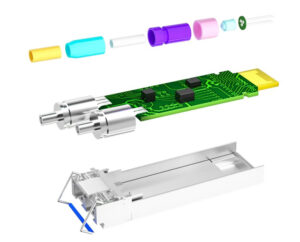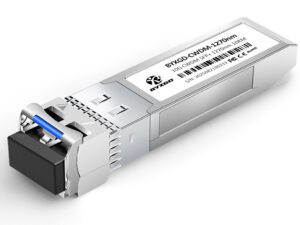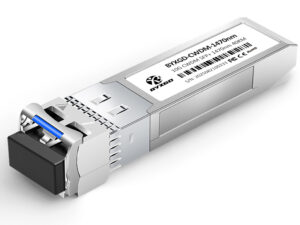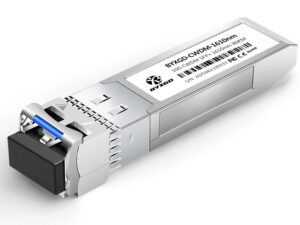Have you experienced network capacity problems and do not know the best, cost-effective solutions to expand fiber? Can you imagine increasing the capacity of your 10G network while cabling becomes less and less expensive? The 10G CWDM SFP+ module can do that by using efficient wavelength multiplexing to multiply the number of data channels you can transmit over your existing fiber.
This document explores how this technology can optimize fiber deployment, simplify network upgrades, and reduce operating costs. By following this document, you will gain the practical insights you need to identify, deploy, and maintain these modules to provide you with scalable, reliable, and effective 10G connectivity for your specific network needs.

10G CWDM SFP+: Why It’s the Ideal Choice for Metro and Enterprise Interconnect
10G CWDM SFP+ modules provide the capability for your network to send several 10G channels over a limited number of fiber strands using Coarse Wavelength Division Multiplexing (CWDM) technology. CWDM systems are different from standard SFP+ modules that require a separate fiber for each link. CWDM combines many signals on different wavelengths onto one fiber. CWDM modules are beneficial in cases where fiber is not available or renting fiber is too expensive.
Cost and Fiber Savings Compared to Other Technologies
In comparison to Dense Wavelength Division Multiplexing (DWDM) systems, 10G CWDM SFP+ modules are cheaper and easier to implement as the channels are spaced further apart (typically 20 nm vs. 0.8 nm in DWDM). The tolerance of the channel spacing reduces the complexity of the lasers and filters used in the modules to manage the channels and ultimately reduces the costs overall while still providing multiple channel capacity.
A comparison is outlined below:
| Feature | 10G CWDM SFP+ | 10G DWDM SFP+ | Standard 10G SFP+ |
| Channel Spacing | 20 nm | 0.8 nm | N/A (single channel) |
| Max Channels per Fiber | 18 | 80+ | 1 |
| Module Cost | Lower | Higher | Lowest |
| Fiber Usage | Reduced (multiple on one fiber) | Highly reduced | One fiber per link |
| Deployment Complexity | Moderate | High | Low |
| Typical Use Cases | Metro, enterprise links | Carrier, long haul | Short-range links |
Streamlined Deployments, with Real Value
10G CWDM SFP+ modules provide a streamlined deployment method, as these modules easily integrate into an existing fiber infrastructure without requiring costly DWDM multiplexing systems or extensive changes to fiber.
This leads to:
- Reduced Capital Expenditures (CapEx) by requiring less fiber and hardware resources
- Quicker install times due to less complex management of the channels
- Greater utilization of current fiber assets while avoiding expensive fiber construction and leasing
Think of the 10G CWDM SFP+ modules as an economical option in the optical spectrum, like a well-designed and organized shipping lane; each lane is used well and traffic flows smoothly without having to rely on a more complex design, such as a more expansive shipping lane.
By addressing affordable channel capacity while balancing the design to be effective with fiber reduction, 10G CWDM SFP+ modules provide a value proposition to enterprises and metros with their ability to manage scalable and cost-effective interconnectivity.
This position supports the tremendous value of CWDM 10G fiber optic modules as a dependable and affordable solution for networks accommodating requirements across simple and complex attributes.
10G CWDM SFP+ Technology and a Consideration Decision Guide
Coarse Wavelength Division Multiplexing (CWDM) utilizes an optical range of wavelengths usually spanning from 1270 nm to 1610 nm, divided into a standard of 18 channels spaced 20 nm apart in wavelength. The wider channel spacing allows for an easier laser or filter design due to spacing and pricing, enabling a 10G CWDM SFP+ module to operate with multiple streams of data over reduced fiber.
CWDM Wavelength Chart and Channels
| Channel Number | Wavelength (nm) | Channel Number | Wavelength (nm) |
| 1 | 1270 | 10 | 1450 |
| 2 | 1290 | 11 | 1470 |
| 3 | 1310 | 12 | 1490 |
| 4 | 1330 | 13 | 1510 |
| 5 | 1350 | 14 | 1530 |
| 6 | 1370 | 15 | 1550 |
| 7 | 1390 | 16 | 1570 |
| 8 | 1410 | 17 | 1590 |
| 9 | 1430 | 18 | 1610 |
These 18 channels allow for multiple 10G signals to be multiplexed onto a single fiber, making the best use of the capacity of the fiber without all the complication and expense of using Dense Wavelength Division Multiplexing (DWDM).
Selection Decision Tree SFP+ CWDM 10G modules
When selecting 10G CWDM SFP+ modules for 10G CWDM, you should consider the following:
Distance of Transmission:
- Up to 80 km = Standard CWDM modules can be used with relatively low complexity
- Beyond 80 km = Will require signal amplification or the use of special modules
Number of Channels:
- A few channels (<8) = Simple multiplexing allows for equipment cost and equipment complexity to be reduced
- All 18 channels = Use CWDM MUX/DEMUX for all 18 full channels
Budget:
- Fixed wavelength modules can cost less and be used to deploy the static channel plan cost-effectively
- Modular and tunable wavelength modules have higher costs but are more flexible
Support for CWDM MUX / DEMUX and Vendor Compatibility
10G CWDM SFP+ modules should be matched to the exact wavelengths defined for each channel in the CWDM MUX/DEMUX to avoid the chance of signal degradation or interference.
Major network vendors support 10G CWDM SFP+ modules, such as Cisco, Huawei, and Juniper. Checking device compatibility and firmware will reduce the potential for implementation issues.
Important Considerations Table
| Criteria | Recommendation | Notes |
| Channel Wavelength | Follow 1270–1610 nm grid | Maintain accurate channel assignments |
| Transmission Range | Up to 80 km | Use amplifiers for extended reach |
| Channel Count | 1 to 18 channels | MUX/DEMUX capabilities vary |
| Equipment Compatibility | Confirm vendor support | Prevents module rejection |
| Budget | Fixed wavelength lowers costs | Tunable modules add flexibility |
10G CWDM SFP+ Product Lineup

BYXGD-10G-CWDM-SFP+-1270nm-10KM: The 10G CWDM SFP+ module is capable of supporting single-mode fiber transmission up to 10 km at a 1270 nm wavelength. This module uses a DFB laser with an output power ranging from -2 to +3 dBm, a PIN receiver sensitivity of ≤ -14 dBm, an extinction ratio of 3.5 dB, and has an LC interface.

BYXGD-10G-CWDM-SFP+-1470nm-40KM: This 10G CWDM SFP+ module works with single-mode fiber up to 40 kilometers at wavelengths from 1470 to 1610 nm. The laser is an EML laser with -1 to +3 dBm output. The PIN can receive signals up to -16 dBm sensitivity with an extinction ratio of 9 dB. It has an LC interface.

BYXGD-10G-CWDM-SFP+-1610nm-80KM: Our 10G CWDM SFP+ module is designed to transmit over single-mode fiber at distances up to 80 km; it is compatible with wavelengths covering 1470–1610 nm. The SFP+ module utilizes an EML laser with an output of 0 to +4 dBm at the optical interface, an APD receiver sensitivity of ≤ -24 dBm, a 10 dB minimum extinction ratio, and an LC interface.
Real-World Example
CWDM is similar to a freeway that is wide, multi-laned, and has plenty of room for traffic flow, unlike DWDM, which has narrower and densely spaced lanes requiring more precision.
When your network professionals become adept in CWDM theory of wavelength division, selection, and compatibility, they can correctly deploy a CWDM 10G SFP module at the best price point while achieving the performance required in metro and enterprise networks.
Scenario Applications and Real-World Customer Case Study of 10G CWDM SFP+
10G CWDM SFP modules are primarily most effective in metro Ethernet applications, enterprise campus network interconnects, and fiber leasing. CWDM 10G SFP module(s) use the practice of adding more lanes for each fiber while maintaining 10G native protocol to increase channel density for more capacity and efficiency when there is a limited amount of fiber available to lease, when the spool/length of fiber is more expensive, or there are simple fiber creek limitations.
Common Applications:
- Metro Ethernet: A service provider can avoid expensive leased fiber and bandwidth options between their central offices to connect to their data center.
- Enterprise Campus Networks: An enterprise can use existing 2 strands of fiber from 2 buildings. Using 10G CWDM SFP modules, it is possible to check the bandwidth utilization from both buildings without upgrading all the infrastructure or paying for additional leased fiber circuits.
- Fiber Leasing: Both fiber providers and enterprises can optimize the density of their channels and reduce the circuits needed between leased fiber.
Real-World Customer Case Study
A large medical institution was facing several challenges with growing data utilization among their hospitals and associated clinics. They may not have been adding new contracts for fiber leases but were simply adding capacity. There were finite capabilities for both leased fiber contracts and few options. The facilities had existing expensive leased fiber connectivity to the data center and other hospital outbuildings.
Challenges Faced:
- High leasing costs of fiber circuits; the recurring costs were stifling any serious network growth.
- There was a high and urgent need for extremely reliable 10G speed links to be supported for advanced medical applications, so an intermediate speed was not an option.
Solution
The healthcare provider deployed CWDM SFP modules along with CWDM MUX/DEMUX configurations to have multiple 10G channels over fewer fibers utilized or over two strands. This reduced the number of fibers used and made the existing infrastructure as efficient as possible.
Results and ROI
- The provider was able to reduce fiber lease expenses by up to 70% by maximizing existing fiber utilization and capacity.
- Data throughput tripled and supported high-bandwidth applications for telemedicine and high-detail imaging.
- The time to deploy decreased significantly as the providers only made adjustments with existing fiber and installed multiple modules with minimal disruption to the hospitals’ local and dependent operations.
Why 10G CWDM SFP+ is the Best Solution Here
10G CWDM SFP+ modules provide real growth and potential best outcomes for scale, efficiency, and ease of deployment in a very complex healthcare environment and clinical applications where application and performance speed were critical to their health system.
Key Benefits Summary
- They allowed limited fiber resources to be preserved as each fiber carried many channels with overhead for utilization.
- They made network upgrades simpler and reduced costs without disruptive infrastructure improvements or changes.
- They provided much lower operating expenses while providing better utilization.
This is a classic case study of leveraging 10G CWDM SFP+ to enable scalable and cost-effective connectivity in constrained fiber environments.
FAQs and Future Outlook on 10G CWDM SFP+ Technology
Yes. CWDM and DWDM are optimized for different requirements: CWDM is appropriate for metro and enterprise networks with fewer channels and lower density, while DWDM is best suited for carrier networks that require higher channel density. They can coexist in the same network on separate fibers or separate layers to get the most out of available bandwidth and lower cost.
Use a high-quality single-mode fiber that has a very low amount of attenuation. Make sure the connectors are clean and avoid sharp bends in the cable. Proper polarity and labeling are required to prevent lock-in in the CWDM multiplexing layer.
Most of the modules should work with leading brands such as Cisco, Huawei, and Juniper. Make sure you have reviewed compatibility lists and studied any firmware compatibility for the devices to help with interoperability.
10G CWDM SFP+ will be a key technology for low-cost fiber capacity expansion in metro and enterprise networks. As a network’s speed increases to 25G and 100G, CWDM can also be used to accelerate fiber capacity and serve as a flexible, scalable option for competitor technologies.
CWDM technology adds tunable optics, channel management improvements, and energy efficiency in fiber optics, and will continue to have a place in future generations.
Contact Us For The Best Solution
It is very important to choose the appropriate 10G CWDM SFP+ modules—minimizing operational cost, maximizing the use of fibers, and simplifying future network growth and expansion. The combination of high capacity, robustness, scalability, and affordability makes the 10G CWDM SFP+ module an ideal choice for metro and enterprise networks.
Review the many different 10G CWDM SFP+ solutions available to meet your needs. Consult with a specialist to help with optimization and integration, and help put your network on a cost-efficient growth path.
